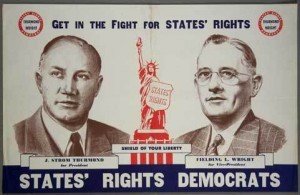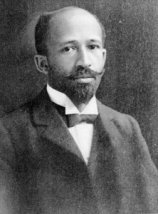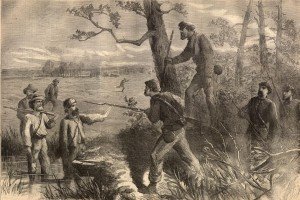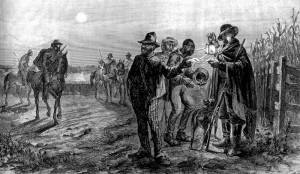Filed under: Anti-fascist, Labor, Southeast, White Supremacy
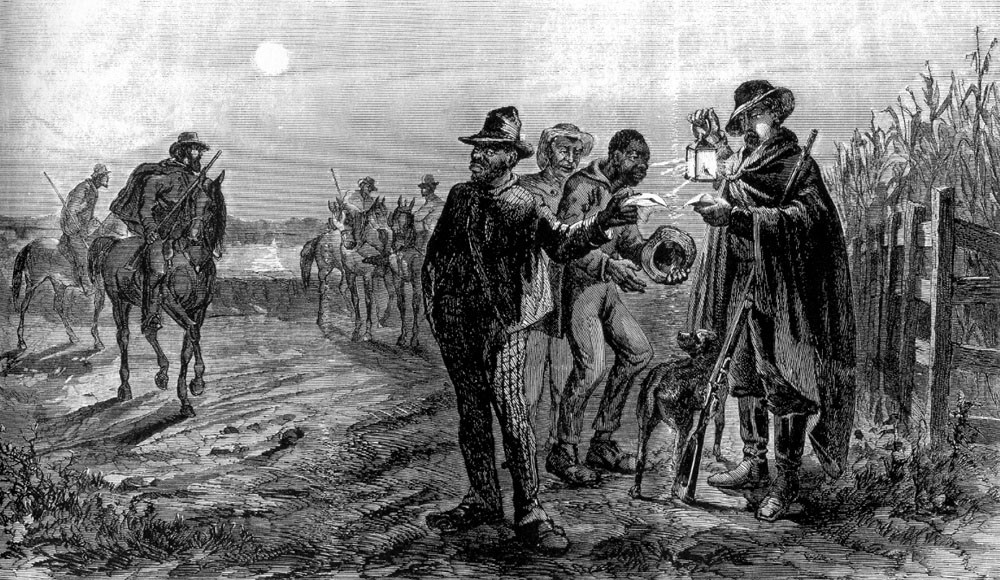
Originally posted to It’s Going Down
Church leaders, politicians, and the heads of national organizations are pleading for calm and peaceful protests,[1] as a slew of Confederate statues, monuments, and graveyards have been vandalized (sometimes repeatedly) with everything to “Black Livez Matter,” to “RBGz”[2] throughout the South. The anti-Confederate backlash ignited by the Charleston massacre points to gaping wounds still clearly present in American society and targets the symbols of the old order for destruction – with the Confederate flag in particular. But the growth of the movement to take down the flag along with other Confederate relics and the rise of white reaction to defend them begs a big question: how did such a symbol rise to such prominence?
Ironically, the flag was in actuality never the official flag of the Confederate States of America, (instead, a Confederate Battle Flag), but nevertheless became a popular symbol as it was used by the States Rights Party[3] also known as the ‘Dixiecrats:’ uber-racist Democrats who mobilized to defend ‘the Southern way of life’ and the Jim Crow South. During the civil rights movement and the fight to desegregate American society, the Battle Flag became just that, a symbol of white supremacy in the face of the black struggle for equal rights.[4] When the Confederate flag was incorporated into the Georgia state flag in the wake of Brown vs. Board of Education, for instance,[5] the State Senate wrote in a report: “Resisting, avoiding, undermining, and circumventing integration was the 1956 General Assembly’s primary objective. The adoption of the battle flag was an integral, albeit small, part of this resistance.”[6]
Other states quickly followed suit, as the flag became a staple of white opposition to a post-Civil Rights America. In many ways, this is why use of the flag has proliferated throughout the United States outside of the South, precisely because it is still seen as symbol of racist resistance to a desegregated society. In many ways, this fit into the narrative of Yankee control over the South and its white population; a narrative that is given credence during the Civil-War and today. But moreover, such a symbol grew in power precisely because it was supported, popularized, and given eminence by the State.
In a post-Charleston world however, in the face of growing anger large retailers such as Amazon.com and Wal-Mart all pulled the Rebel Flag quickly off their shelves. This move prompted a response from (almost entirely) reactionary right-wing whites,[7] leading to heated and confrontational protests across the country.[8] Demonstrations in Southern cities against the flying of the Confederate flag quickly led to street clashes between pro and anti Confederate demonstrators. In Columbia, South Carolina, (where the Confederate flag flew high in the wake of Charleston while all others were lowered),[9] a brawl broke out on the grounds of the Statehouse, when a group of largely black protesters clashed with a group of white Confederate supporters.[10] Across the South, the battle over the future of the vestiges of the Confederacy was being drawn; largely along lines of race.
But while the movement to remove the flags and monuments grew in the wake of Charleston, so did the reaction to protect them. On Sunday, July 12th, an 8-mile convoy[11] of over 1.500 vehicles and several thousand more people arrived in the Florida town of Ocala.[12] Ocala was chosen due to a move by an administrator to try and remove the Confederate flag from a government building, but county leaders quickly reversed the decision. The massive rally in Ocala was not without opposition, however. At the last minute, police (in fear that clashes would lead to a larger, more political uprising) steered the caravan away from a local black neighborhood after threats against the rally were reported. These threats turned out to be very real, as someone reportedly fired at least 6 shots in the direction of the “Southern Pride Ride,” although no one was injured and no arrests were made.[13] The Florida rally is part of a growing wave of racist reaction that has been brewing in the US since the Ferguson uprising. “A backlash is beginning,” said Ben Jones, a spokesman for the Sons of Confederate Veterans, which represents 30,000 descendants of Confederate soldiers. “We are putting flags out. Everyone time one is taken down, we put five or six of them up.”[14]
But the backlash is also bringing in numbers of KKK members, Neo-Nazis, and those on the racist right.[15] In the wake of the Charleston killings, various Ku-Klux-Klan chapters began heavily recruiting in areas around the Carolinas and other Southern states.[16] On Saturday, July 18th, it appears that this may come to a head, as anarchists and other radicals are planning a counter-demonstration to a KKK rally on the steps of the Columbia, South Carolina Statehouse, to “Run the Klan Out of Town.”[17] A post on the online white nationalist forum, Stormfront.org, reads that along with the KKK, the Neo-Nazi organization, the National Socialist Movement (NSM), who marches and dresses in full swastika gear, will also be in attendance.[18] NSM rallies in the past have lead to heated street riots in Toledo, Ohio[19] and Phoenix, Arizona,[20] when youth of color and anarchists fought the racists and the police for hours.
We live in a class divided society; of those that work and those that own, but we also live in one that is organized along lines of race. What is happening in the South today, as during the rebellions in Ferguson and elsewhere, is forcing many people to take a side in the struggle. Sadly however, as in much of American history, white supremacy pushes many poor and working-class whites into a position that supports the government and the power structure against people of color. The reasons for this go back to the brutal colonization of the Americas. The US, like other states in the “New World,” was colonized and settled by a wide range of people. A volatile mix of indentured and waged European workers, displaced and enslaved Native Americans, and enslaved Africans formed a potential pool of insurgents with sometimes common enemies.[21] It wasn’t long before laws began to be passed that formerly set into law racial distinctions; from rules regarding intermarriage to the prohibition of African Americans owning firearms. In the South, white supremacy also came with physical benefits for whites, even poor and working-class ones. It allowed them access to politics, land-ownership, and also gave them dominion over blacks. The slave patrols, which monitored black movement and tracked down runaway slaves (and lead to the creation of the modern police force) is a shining example.[22] As W.E.B. Du Bois wrote, whiteness was a “physical and physiological wage.”
While many will not debate the horrors of racial slavery in the US, some still cling to a romantic vision of the South. But the image of the “Southern way of life,” is also a skewed history. Southern society was broken apart by class as well as race; tensions that exploded at times, forcing people to act, sometimes in opposition to whiteness – but often instead, helping to strengthen it.[23] During the Civil War, small farmers and poor wage earning whites faced widespread poverty, while the plantation class mass produced cotton in the hopes of expanding their wealth despite the war effort. Furthermore, as Tony Wikrent writes in the Truth About the Confederacy:
Confederate Congress passed a series of taxes…on all …agricultural products including livestock, fodder, and food crops…Soon, many “impressment officers” were taking far more than one tenth of a farm’s goods. Moreover, they were reluctant to “inconvenience” the richest and most powerful, so they stripped poorer farms almost bare, before even considering what the large plantations might offer.
As one white woman wrote in a letter: “The crime is with the planters . . . as a class, they have yielded their patriotism, if they ever had any, to covetousness . . . . for the sake of money, they are pursuing a course to destroy and demoralize our army—to starve out the other class dependent on them for provisions.” Wikrent goes on to explain how these class divisions helped bring down the Confederacy:
Nearly a quarter of all Union armed forces, nearly one half million, actually came from the South. In the border states, 200,000 whites joined the Union army; only 90,000 joined the Confederate army. Many of these men had deserted the Confederate army. But many more deserters had simply wearied of war, and were in hiding near their homes. By 1864, two-thirds of the Confederate Army was absent with or without leave. So, the story of a unified Confederacy bravely fighting off invading Yankees is a damnable myth. The Confederacy was deeply riven by class divisions, with poor whites almost as hostile to slave holders as slaves were. The truth was that large parts of the South ended up warring against the Confederacy. Within one year of the outbreak of the war, there were entire counties and areas of the South that had broken free of control by either state or Confederate officials. As more deserters came home to hide, they banded together in self defense, and more areas slipped out of Confederate control. In many areas, Confederate officials, especially military conscription officers, were shot on sight, or hunted down and ambushed. The Confederacy, in no small degree, defeated itself.[24]
Furthermore, as in most wars, those owning property, or in this case, more than 20 slaves, were spared from military service in the Confederacy. Wikrent writes:
The slave holder exemption, of course, was based on the slave holders’ fears of a slave revolt – all the prattle about paternalistic love for an inferior race, and that race’s child-like love in return, apparently forgotten. In a number of counties, government officials begged to be released from draft quotas because they feared sending more men off for military service would fatally weaken local slave patrols. C.F. Howell of Jackson County, Mississippi wrote his governor that “now we have to patrol every night to keep them down.” One planter in Alabama ignored the Confederacy’s need for military manpower and openly pleaded with the men of his area to stay at home and save their families “from the horrors of insurrection.”
The slave holder exemption turned out to be a huge mistake, because Confederate soldiers were forced to recognize that the South’s oligarchs had begun the war not so much to fend off supposed Yankee encroachments on their rights, but to preserve slavery and protect the oligarchs’ investment in slave property. Within months, it was a common lament in the ranks that it was “a rich man’s war but a poor man’s fight.”[25]
Among poor whites deserting the Confederate army, anger grew against the new government. “One planter in the area wrote how he and his fellow oligarchs were terrified that the Unionists among the lower classes had “gone so far as to declare [they] will take the property from the rich men & divide it among the poor men.”[26] The Southern system, which was held together through white supremacy that sought to manage and control the slave population, came apart. As former South Carolina governor James Henry Hammond wrote in a letter, “The poor hate the rich & make war on them everywhere & here especially with universal suffrage. . . The war is based on the principle and fact of the inequality of mankind—for policy we say races, in reality, as all history shows is as the truth is classes.”[27] This undoing of Southern society was also aided as W.E.B. Du Bois wrote in Black Reconstruction, by the mass general strike of black slaves, who fled their plantations during the conflict.[28]
In the aftermath of the war, groups such as the Ku-Klux-Klan were formed to terrorize the now free black workers, keep them from arming themselves, gaining access to land, and hindering attempts at drastically changing Southern society during reconstruction.[29][30] The KKK and other groups also often took aim at whites who fought against racism. Albert Parsons, a former Confederate soldier who became an organizer for the rights of freed slaves in Texas, was driven from his home along with his partner, Lucy Parsons, a former slave. Settling in Chicago, Lucy and Albert would go on to play large roles in the anarchist movement, an involvement that Albert would give his life to; he was executed as one of the Haymarket Martyrs.[31]
But racial hierarchy wasn’t just re-established through white terror, the planter class also organized, and many freed blacks quickly found themselves working as share croppers; wage-slavery quickly replacing chattel slavery.[32] W.E.B. Du Bois argued that this in effect re-instituted white supremacy in the South after the Civil-War and again placed blacks in a subservient position. Ironically, some poor whites were likewise not allowed to vote as well as a result, something that would not be overturned until the coming of the Civil-Rights movement.
These foundations of white supremacy also proliferated in the labor movement directly after the war, where formal (white) unions often opposed black membership and instead urged blacks to organize their own unions in an effort to keep white labor elevated.[33] Du Bois argues that such a position was disastrous, as it kept workers organized against each other instead of against the bosses. He wrote: “When white laborers were convinced that the degradation of Negro labor was more fundamental than the uplift of white labor, the end was in sight.”
Class warfare did at times lead to joined action of white and black workers. During the Great Railroad Strike of 1877,[34] one of the most insurrectionary labor episodes in American history for instance, white and black workers acted together. However, even in these revolts, formal organizations such as unions attempted to uphold white supremacy. Noel Ignatiev wrote of the St. Louis general strike that was part of what became known as, ‘The Great Upheaval:’ “In that strike the white leadership of the Workingmen’s Party turned away five hundred black workers who sought to join it, did their best “to dissuade any white men from going with the [blacks],” and called off public activities rather than open them to black participation.” Du Bois commented: “[T]he labor movement, with but few exceptions, never realized the situation. It never had the intelligence or knowledge, as a whole, to see in black slavery and Reconstruction, the kernel and meaning of the labor movement in the United States.”[35] Du Bois referred to this refusal of the white working-class to confront white supremacy as “the American blindspot.”
Some labor militants did learn from this disaster, as did the revolutionary syndicalist American union, the Industrial Workers of the World (IWW), which was founded in 1905 on the principle of organizing all workers, regardless of gender or race, for the overthrow of capital. In 1913, Mary Ovington, one of the founders of the NAACP remarked that the IWW was, “[Along with the NAACP], the second organization that attacks Negro segregation . . . The I.W.W. has stood with the Negro.”[36] Starting in the 1910s, the IWW began attempting to organize large numbers of black workers and being that it was one of the only unions open to them, many joined. In the South, the IWW also fought against racism and lynching, both in action and in word. In one Wobbly Southern paper, The Voice of the People, one Wobbly wrote: “[F]ellow workers of the South if they wish real good feeling to exist between the two races…please stop calling the colored man ‘Nigger’…Call him Negro if you must refer to his race, but ‘fellow worker’ is the only form of salutation a rebel should use.”[37] Such organizing led to mass action, for instance in Louisiana, where the IWW led large strikes of both black and white loggers.
Those that call to defend the history of the Confederacy support a legacy of white supremacy, slavery, and ultimately a drastically stratified society – then as now. We should celebrate the real heritage of the South; from the insurrectionary acts of John Brown to the anti-capitalist organizing of the IWW. Whites, often poor and working-class, find pride in the Confederate flag because it gives them a sense of identity in society while connecting them to a perceived position of power and privilege over others. While the flag is portrayed as a defiant symbol in the face of Northern aggression, in reality it is an image that has been manufactured and promoted by the likes of plantation owners and governors – all in the hopes that the poor will never band together.
At times of instability and crisis, those on the far-right will attempt to maneuver and capitalize on already held prejudices within the population. Playing up fears of black revolt and support for ‘Southern Heritage,’ groups such as the KKK are mobilizing to expand their influence. But a look at the history of the Confederacy shows that support for it was never rock-solid or across the board – it fell apart as people realized the contradictions inherent within a system of exploitation, violence, and control. Furthermore, the resistance, escape, mutiny, and desertion of black slaves and white workers and soldiers showed that mass refusal can bring about a crisis within a massive system. And within such a crisis, people can attack power, property relations, and racial divisions; creating new forms of life and ways of sustaining themselves.
Those seeking the destruction of State power and the systems of profit and domination they are designed to protect should take note of this history. Against us, stands the total power of the government, the terror of racist reactionaries, and the weight of over 500 years of colonial white supremacy. There are no easy answers, but we must find ways at breaking apart the cracks, deepen the contradictions, and bring struggles together. Racism is the glue that holds this system together and helps it continue to function. This was true in the 1860s as it is true today.
When soldiers refuse to fight, there is no army. When workers refuse to police others, there are no cops. When slaves refuse to live in bondage, there are no masters.
Until all the flags are burned.
[1] www.washingtontimes.com/news/2015/jun/18/black-activists-fear-race-war-amid-charleston-shoo/
[2] itsgoingdown.org/regions/south/anti-confederate-vandalism-and-protests-continue-to-intensify/
[3] theweek.com/articles/562004/surprisingly-uncomplicated-racist-history-confederate-flag
[4] www.huffingtonpost.com/2015/06/22/confederate-flag-racist_n_7639788.html
[5] theweek.com/articles/562004/surprisingly-uncomplicated-racist-history-confederate-flag
[6] www.senate.ga.gov/sro/Documents/StudyCommRpts/00StateFlag.pdf
[7] www.wtsp.com/story/news/local/2015/06/27/confederate-flag-protest-gets-heated-in-brooksville/29392915/
[8] www.usatoday.com/story/news/nation/2015/07/06/phoenix-confederate-flag-rally/29758277/
[9] www.huffingtonpost.com/2015/06/22/confederate-flag-racist_n_7639788.html
[10] www.theblaze.com/stories/2015/06/29/things-just-got-violent-dueling-confederate-flag-protests-outside-s-c-statehouse-nearly-plunge-area-into-chaos/
[11] www.dailymail.co.uk/news/article-3158958/Thousands-Confederate-flag-supporters-rise-Florida-rally-eight-mile-convoy-pickups-motorbikes-cars-support-embattled-symbol.html
[12] www.rawstory.com/2015/07/backlash-is-beginning-miles-long-convoy-of-confederate-flag-supporters-rally-in-florida/
[13] www.nydailynews.com/news/national/confederate-flag-supporters-flock-central-florida-rally-article-1.2290300
[14] www.rawstory.com/2015/07/backlash-is-beginning-miles-long-convoy-of-confederate-flag-supporters-rally-in-florida/
[15] blackcatnotes.com/2015/06/30/how-are-racists-responding-to-the-church-shooting-and-confederate-flag-controversy/
[16] www.wral.com/once-again-kkk-uses-fliers-to-recruit-in-central-nc/14745985/
[17] itsgoingdown.org/regions/south/callout-to-smash-the-klan-in-columbia-sc/
[18] www.stormfront.org/forum/t1109978/
[19] en.wikipedia.org/wiki/2005_Toledo_riot
[20] firesneverextinguished.blogspot.com/2010/12/riot-si-se-puede.html
[21] clogic.eserver.org/1-2/allen.html
[22] plsonline.eku.edu/insidelook/brief-history-slavery-and-origins-american-policing
[23] itsgoingdown.org/regions/south/saralee-and-neal-dixie-be-damned/
[24] www.correntewire.com/truth_about_confederacy
[25] www.correntewire.com/truth_about_confederacy
[26] www.correntewire.com/truth_about_confederacy
[27] www.correntewire.com/truth_about_confederacy
[28] libcom.org/library/w-e-b-du-bois-proletariat-black-reconstruction-ferruccio-gambino
[29] en.wikipedia.org/wiki/Black_Reconstruction
[30] libcom.org/library/american-blindspot-reconstruction-according-eric-foner-web-du-bois-noel-ignatiev
[31] www.blackpast.org/1886-lucy-parsons-i-am-anarchist
[32] muse.jhu.edu/login?auth=0&type=summary&url=/journals/journal_of_world_history/v008/8.1karras.pdf
[33] libcom.org/library/american-blindspot-reconstruction-according-eric-foner-web-du-bois-noel-ignatiev
[34] libcom.org/history/great-upheaval-1877-jeremy-brecher
[35] libcom.org/library/american-blindspot-reconstruction-according-eric-foner-web-du-bois-noel-ignatiev
[36] libcom.org/files/Foner_PS_-_The_IWW_and_the_Black_Worker.pdf
[37] isreview.org/issue/86/legacy-iww


